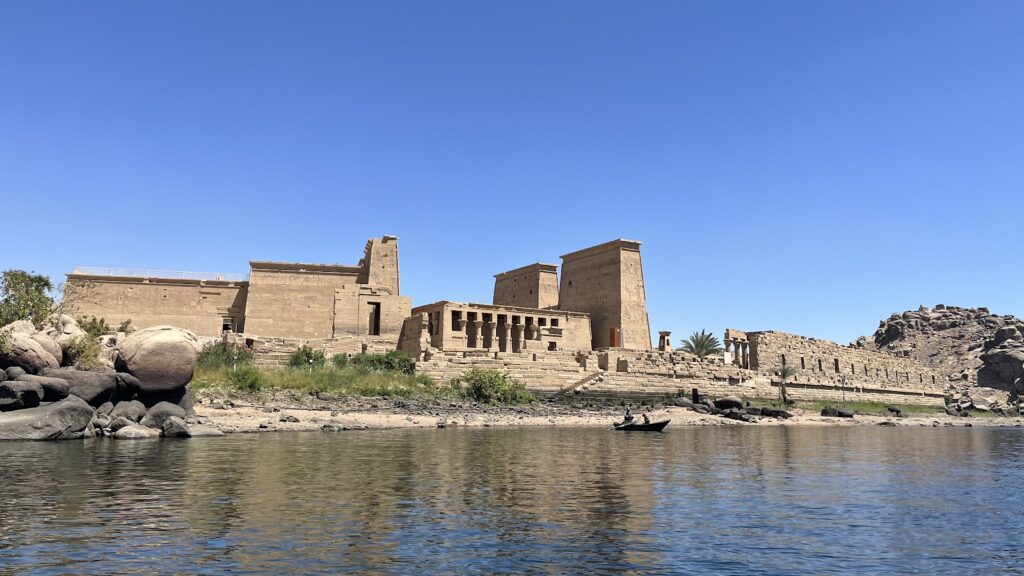Table of Contents
ToggleDendera Temple – A Masterpiece of Ancient Egyptian Architecture
Where Is the Dendera Temple Located?
The Dendera Temple is located in Dendera, the capital of Egypt’s sixth Upper Egypt region. With its distinctive style and layout, it is a magnificent example of the beauty and grandeur of Egyptian temples during the Greek and Roman periods.
Dedication to the Goddess Hathor
Temple Design and Notable Features

The temple is specifically dedicated to Hathor, the goddess associated with birth, beauty, and music. It was built in 54 BC and resembles the Temple of Edfu in design and structure, but is larger. The size and area of the corridors and staircases leading to the roof, the huts constructed on the temple roof, the huge mudbrick wall surrounding the temple, the sacred lake attached to the temple, and the Mamisi (birth house) are all notable features.
Foundation, Layout, and Dimensions
The foundation stone was laid by Ptolemy III using sandstone and was later enhanced by many Roman emperors. The temple’s length is approximately 79 meters, covering an area of about 83,600 square meters. Its square façade is one of the most magnificent ancient temple facades, measuring 12.5 meters high and 35 meters wide.
The Architectural Beauty of Dendera
Columns, Halls, and Ceiling Art
It features a system of wall curtains—walls that reach halfway up the column shafts—and contains six massive columns with capitals shaped like Hathor’s head. The entrance leads to a hypostyle hall with 32 columns, followed by a smaller columned hall with 18 columns topped with capitals.
The ceiling of this hall is decorated with the Sistrum instrument, symbolizing Hathor’s head, adorned with splendid astronomical scenes in vivid colors.
Dendera Temple Complex – Well-Preserved and Visually Stunning
Religious Significance and Visitor Experience
The Dendera Temple Complex stands out as one of the most well-preserved temple sites in all of Egypt. Nestled near the west bank of the Nile in Qena Governorate, this impressive structure offers a deep dive into the religious and astronomical knowledge of ancient Egyptians. As the Temple of Hathor, the goddess of love, music, and motherhood, Dendera reflects the spiritual devotion of the Ptolemaic and Roman eras. Visitors to the Dendera Temple are often struck by the incredibly vivid carvings and the temple’s remarkable symmetry, which exemplify the brilliance of ancient Egyptian architecture. The inner sanctuaries, ceremonial halls, and stairways lead to rooftop chapels, offering a panoramic view that remains a favorite among travelers.
The Dendera Zodiac – An Astronomical Marvel
Among its most captivating features is the Dendera Zodiac, a celestial map etched into the temple ceiling. This masterpiece not only showcases the artistic skills of the era but also reveals the ancient Egyptians’ advanced understanding of astronomy and the cosmos. While the original zodiac was relocated to the Louvre Museum, the temple retains a replica that continues to amaze scholars and tourists alike.
Restoration and Modern Access
Recent Discoveries and Renovation Efforts
In recent years, extensive restoration projects have unveiled even more of the temple’s crypts, corridors, and colorful reliefs. These efforts have revitalized interest in the Dendera Temple Complex as a top historical attraction in Egypt. Today, the temple draws both casual visitors and academic researchers eager to explore its blend of mythology, science, and architectural grandeur. Whether you are interested in ancient gods, sacred rituals, or early astronomy, Dendera is a must-visit destination in 2025.
Zodiac’s Historical Journey and Current Display
The temple is most famous for the Dendera Zodiac, the first known zodiac representation, discovered in 1799 in a special niche for Osiris on the temple roof. The western half of this sandstone ceiling panel measures 255 cm by 253 cm and depicts the movement of stars, including constellations such as Scorpio, Sagittarius, Gemini, Taurus, Aries, and others.
In 1827, Muhammad Ali Pasha gifted this zodiac to France, and it is now exhibited in the Louvre Museum in Paris.
Tourist Access and Panoramic Views
In 2020, Egypt’s Ministry of Antiquities launched a restoration project for the temple. Three of the twelve crypts, where festivals were celebrated, have been opened to visitors following restoration. Additionally, a panoramic view from the roof of the Dendera Temple, which is a popular tourist attraction, has been made accessible.
Popular Hurghada Tours
